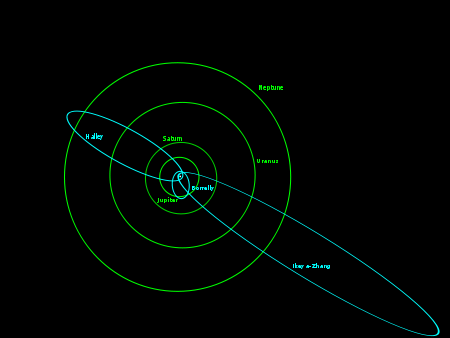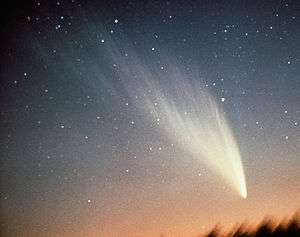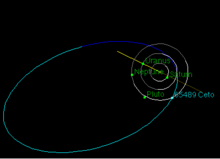List of Solar System objects by greatest aphelion

This is a list of Solar System objects by greatest aphelion or the greatest distance from the Sun that the orbit takes it. For the purposes of this list it is implied that the object is orbiting the Sun in a two-body solution without influence of the planets or passing stars. The aphelion can change significantly due to the gravitational influence of planets and other stars. Most of these objects are comets on a calculated path and may not be directly observable.[1]
The maximum extent of the region in which the Sun's gravitational field is dominant, the Hill sphere), may extend to 230,000 astronomical units (3.6 light-years) as calculated in the 1960s.[2] But any comet currently more than about 150,000 AU (2 ly) from the Sun can be considered lost to the interstellar medium. The nearest known star is Proxima Centauri at 271,000 AU which is 4.22 light years,[3] followed by Alpha Centauri at about 4.35 light years away according to NASA.[3]
Comets are thought to orbit the Sun at great distances, but then be perturbed by passing stars and the galactic tides.[4] As they come into or leave the inner Solar System they may have their orbit changed by the planets, or alternatively be ejected from the Solar System.[4] It is also possible they may collide with the Sun or a planet.[4]
Comets with greatest aphelion (2 body heliocentric)
There can be considerable variation for highly eccentric orbits based on the epoch (date) and whether you calculate a heliocentric or barycentric solution. The aphelion point for heliocentric solutions can be highly inaccurate for objects with an orbital eccentricity approaching 1 especially when values are calculated while the object is near perihelion and has not left the planetary region of the Solar System.


- C/2012 S4 (PANSTARRS) 504443 or 504000±194000 AU[5] (about 8 light-years). Barycentric value in 2200: 2844 AU
- C/2012 CH17 (MOSS) 279825 Barycentric value in 2200: 3642 AU
- For scale, Proxima Centauri, the closest star, is 271000 AU from the Sun[3] (4.25 light years)
- C/2008 C1 (Chen-Gao) 203253 Barycentric value in 2200: 1912 AU
- C/1992 J1 (Spacewatch) 154202 Barycentric value in 2200: 1827 AU
- C/2007 N3 (Lulin) 144828 Barycentric value in 2200: 1210 AU
- C/1937 N1 (Finsler) 115031 Barycentric value in 2200: 3561 AU
- C/1972 X1 (Araya) 108011 Barycentric value in 2200: 2818 AU
- C/2001 C1 (LINEAR) 76230 Barycentric value in 2200: (ejected from Solar System)
- For scale, one light-year is 63245 AU[6]
- C/2002 J4 (NEAT) 57793.08 Barycentric value in 2200: (ejected from Solar System)
- C/1910 A1 (Great January comet) 51589.87 Barycentric value in 2200: 1487 AU
- C/1958 D1 (Burnham) 46408 Barycentric value in 2200: 556 AU
- C/1986 V1 (Sorrells) 37825 Barycentric value in 2200: 4474 AU
- C/2005 G1 (LINEAR) 37498 Barycentric value in 2200: 20289 AU
- C/2006 W3 (Christensen) 35975 Barycentric value in 2200: 4108 AU
- C/2009 W2 (Boattini) 31059 Barycentric value in 2200: 1927 AU
- C/2005 L3 (McNaught) 26779 Barycentric value in 2200: 3429 AU
- C/2004 YJ35 (LINEAR) 26433 Barycentric value in 2200: 1241 AU
- C/2003 H3 (NEAT) 26340
- C/2010 L3 (Catalina) 25609
- C/2014 OE4 (PANSTARRS) 25535
- C/1902 R1 (Perrine) 25066
- C/1889 G1 (Barnard) 24784
- C/2007 VO53 (Spacewatch) 24383
- C/2012 U1 (PANSTARRS) 24373.10
- C/1958 R1 (Burnham-Slaughter) 24299
- C/2010 D3 (WISE) 23255
- C/2001 K5 (LINEAR) 22810
- C/1991 R1 (McNaught-Russell) 22313
- C/2009 U5 (Grauer) 21191
- C/1977 V1 (Tsuchinshan) 19631
- C/1888 P1 (Brooks) 19612
- C/2011 N2 (McNaught) 19536
- C/1910 P1 (Metcalf) 19190
- C/1882 F1 (Wells) 19135
- C/1984 W2 (Hartley) 19000
- C/2002 K1 (NEAT) 18858.66
- C/2002 C2 (LINEAR) 18034.41
- C/2008 Q3 (Garradd) 17850.27
- C/2013 F2 (Catalina) 16812.13
- C/2010 H1 (Garradd) 16721.27
- C/1999 T1 (McNaught-Hartley) 16693.03
- C/2004 P1 (NEAT) 16107.04
- C/1974 F1 (Lovas) 15129.93
- C/2013 J5 (Boattini) 14297.48
- C/2006 Q1 (McNaught) 13768.41
- C/2014 Q6 (PANSTARRS) 13761.35
- C/1975 V1-A (West) 13560.22
- C/1999 F1 (Catalina) 13390.75 (JPL)
- C/2003 T2 (LINEAR) 12893.57
- C/2014 N3 (NEOWISE) 12852.10
- C/1969 T1 (Tago-Sato-Kosaka) 12823.13
- C/2010 J2 (McNaught) 12544.43
- C/1985 R1 (Hartley-Good) 11964.01
- C/1991 T2 (Shoemaker-Levy) 11950.41
- C/2014 W8 (PANSTARRS) 11859.03
- C/2000 B2 (LINEAR) 11809.70
- C/2003 T3 (Tabur) 11462.82
- C/2005 S4 (McNaught) 11381.16
- C/1986 N1 (Churyumov-Solodovnikov) 11336.87
- C/2004 T3 (Siding Spring) 11224.18
- C/1998 M6 (Montani) 10808.43
- C/2007 M2 (Catalina) 10717.08
- C/1906 E1 (Kopff) 10664.77
- C/1976 J1 (Harlan) 10286.15
- C/2002 V2 (LINEAR) 10015.89
- C/1959 X1 (Mrkos) 9946.87
- C/2014 N2 (PANSTARRS) 9490.90
- C/2012 LP26 (Palomar) 9371.71
- C/1898 V1 (Chase) 9265.83
- C/1952 M1 (Peltier) 9208.95
- C/2002 L9 (NEAT) 8905.72
- C/2009 T3 (LINEAR) 8598.88
- C/1983 N1 (IRAS) 8335.51
- C/2012 K6 (McNaught) 8257.46
- C/2007 T1 (McNaught) 8071.94
- C/1992 U1 (Shoemaker) 7853.90
- C/1948 N1 (Wirtanen) 7766.64
- C/1981 M1 (Gonzalez) 7712.05
Distant periodic comets with well-known aphelion

These can also change significantly such as if perturbed by Jupiter
- 153P/Ikeya–Zhang (0.5–102)
- 273P/Pons–Gambart (0.8–63)
- 35P/Herschel–Rigollet[7] (0.7–57 AU, returns in 2092)
- Comet Swift–Tuttle [7] (0.96-51 AU)
- 177P/Barnard (1–47)
- Halley's Comet[7] (0.59-35, for many years the most distant aphelia known)
- 165P/LINEAR (7–29)
- 122P/de Vico (0.6–34)
- 12P/Pons–Brooks (0.7–33.5)

Distant comets with long observation arcs and/or barycentric

Examples of comets with a more well determined orbit. Comets are extremely small relative to other bodies and hard to observe once they stop outgassing (see Coma (cometary)). Because they are typically discovered close to the Sun, it will take some time even thousands of years for them to actually travel out to great distances. The Whipple proposal might be able to detect Oort cloud objects at great distances, but probably not a particular object.
- Comet West 70,000 AU[8] (1.1 light-years)
- C/1999 F1 (Catalina) 66,600 AU[9] (1.05 light-years)
- C/2012 S4 (PANSTARRS) 5700 AU (barycentric)[10]
- Comet Hyakutake (C/1996 B2) 3410 AU[11]
- C/1910 A1 (Great January comet) about 2974 AU (barycentric)[12]
- C/1992 J1 (Spacewatch) 3650 AU[13]
- C/2007 N3 (Lulin) 2400[14]
Minor planets
A large number of trans-Neptunian objects (TNOs) – minor planets orbiting beyond the orbit of Neptune – have been discovered in recent years. Many TNOs have orbits with an aphelion (farthest distance to the Sun) far beyond Neptune's orbit at 30.1 AU. Some of these TNOs with an extreme aphelion are detached objects such as 2010 GB174, which always reside in the outermost region of the Solar System, while for other TNOs, the extreme aphelion is due to an exceptionally high eccentricity such as for 2005 VX3, which orbits the Sun at a distance between 4.1 (closer than Jupiter) and 3080 AU (a hundred times farther from the Sun than Neptune). The following is a list of TNOs with the largest aphelion in descending order.[15][16]
| Aphelion in AU |
Number of bodies |
|---|---|
| 200–300 | 12 |
| 300–400 | 7 |
| 400–500 | 5 |
| 500–600 | 4 |
| 600–700 | 4 |
| 700–800 | 1 |
| 800–900 | 0 |
| 900–1000 | 4 |
| 1000–1500 | 4 |
| Beyond 1500 | 3 |
TNOs with an aphelion larger than 200 AU
The following group of bodies have orbits with an aphelion above 200 AU.[15]
- 2005 VX3 3197 AU
- 2012 DR30 2651[1]
- 2013 AZ60 1648
- 2015 WZ 1465
- (308933) 2006 SQ372 1448[17]
- 2002 RN109 1340
- (87269) 2000 OO67 1036[1]
- 2010 BK118 982[16]
- 2007 TG422 973[18]
- 90377 Sedna 938[19]
- 2007 DA61 918[15][16]
- 2010 GB174 693.65
- (418993) 2009 MS9 684.89
- (336756) 2010 NV1 638.18
- 2004 VN112 601.66 about 600 AU[20][21]
- 2013 RF98 588.25
- 2015 SO20 555.22
- 2011 OR17 520.83
- 1996 PW 517.76
- 2006 UL321 498.03
- 2012 KA51 443.99
- 2012 VP113 441.49
- (82158) 2001 FP185 415.42
- (148209) 2000 CR105 413.74
- 2002 GB32 392.45
- 2003 SS422 349.95
- 2007 VJ305 343.51
- 2010 GW147 338.43
- (468861) 2013 LU28 333.46
- 2005 PU21 316.73
- 2015 TS350 311.84
- 2003 HB57 289.13
- (445473) 2010 VZ98 273.45
- 2005 RH52 263.84
- 2013 GP136 262.26
- 2013 JO64 255.92
- (353222) 2009 YD7 241.13
- 2007 TU431 233.66
- 2007 LH38 233.21
- (54520) 2000 PJ30 216.89
- 2015 FK37 205.85
- (181902) 1999 RD215 205.32
- 1999 CZ118 200.46
TNOs with an aphelion between 100 and 200 AU


The following group of bodies have orbits with an aphelion between 100 and 200 AU.[22]
- 1999 DP8 196.80
- 2004 NN8 192.66
- 65489 Ceto 187.35
- (437360) 2013 TV158 186.02
- (303775) 2005 QU182 184.31
- (29981) 1999 TD10 180.96
- (184212) 2004 PB112 177.65
- 2000 KP65 174.90
- (91554) 1999 RZ215 170.33
- 2015 RK245166.18
- 2010 ER65 159.36
- (118702) 2000 OM67155.66
- 2003 QM112155.11
- 2013 LD16 154.88
- 2008 ST291 154.54
- 2011 HO60 152.60
- (145474) 2005 SA278 151.92
- 2014 XS3 151.15
- (26181) 1996 GQ21 150.26
- 2008 LP17 150.21
- 2012 UK177 149.00
- 1999 CY118 148.99
- 2005 RP43 147.76
- 2006 HQ122 146.42
- (145451) 2005 RM43 146.34
- 2010 JJ124 144.80
- 2007 FN51 144.58
- 2003 YQ179 143.11
- (307982) 2004 PG115 142.29
- 1999 CF119 142.00
- 2013 GZ136 141.20
- (82155) 2001 FZ173 140.65
- 2007 LF38 137.23
- 2005 EF304 136.55
- 2008 JO41 134.86
- 2010 JH124 134.61
- 2003 QY91 133.01
- 2010 PU75 132.36
- (15874) 1996 TL66 132.31
- 2000 CP105 131.89
- 1999 RZ214 131.59
- 1999 DG8 131.43
- 2010 EQ65 128.88
- 2006 HV122 125.29
- 2001 FK194 124.69
- 2013 BN27 124.00
- 2005 OE 122.61
- 2013 SE99 122.49
- 2004 TF282 122.26
- 2010 GW64 122.06
- 2013 JR64 120.29
- 2001 KZ76 119.78
- 2012 HD2 119.71
- 2000 SQ331 119.14
- 2011 UW412 118.38
- 2015 TN178 117.10
- 2004 VM131 116.26
- (451657) 2012 WD36 116.08
- 2003 LA7 116.03
- 2003 FH129 115.74
- 2013 JV64 114.48
- (127546) 2002 XU93 114.38
- 2000 PF30 114.14
- 2000 PH30 114.11
- 2005 PT21 112.78
- 2011 UP411112.60
- (229762) 2007 UK126 110.12
- 2012 UR177 110.01
- 2007 TA418108.89
- 2009 KN30 108.88
- 2014 WT69 108.76
- 2006 HO122
- (65407) 2002 RP120 107.21
- 2003 OS33 107.04
- 2010 EK139 107.02
- 2014 FC69 106.92
- 2007 LJ38 106.85
- (126619) 2002 CX154 106.47
- (160148) 2001 KV76 105.22
- 2007 RM314 104.28
- (145480) 2005 TB190 104.21
- 2011 FY9 104.07
- 2006 HX122 103.78
- 2000 AB229 103.10
- 2010 RM45 102.63
- 2013 JD64 102.57
- 2001 OM109 101.79
- 2001 OT108 101.44
- (225088) 2007 OR10 100.75
- 2007 TR436 100.50
TNOs with an aphelion between 90 and 100 AU

- 2011 UQ412 99.74
- 2001 FN194 98.95
- 2000 YY1 98.49
- 2005 LC54 98.43
- 2004 VH131 97.64
- 136199 Eris (2003 UB313) 97.63
- 2000 SS331 96.89
- 2000 QK226 96.75
- 2006 QH181 96.73
- 2004 VG131 96.63
- 2014 GE45 96.36
- 2003 QK91 96.05
- 2009 DJ143 95.68
- 2001 FJ194 95.05
- 2010 RE64 94.99
- 2006 QJ181 94.48
- 2006 QG181 94.34
- 2000 PS30 93.93
- 2008 OG19 93.82
- 2011 US411 93.53
- 2014 QR441 92.37
- 1998 XY95 92.36
- (136120) 2003 LG7 92.34
- 2004 HQ79 90.96
- 2009 KX36 90.89
Comparison

See also
- List of trans-Neptunian objects (this just has the TNO's not very long period comets)
- List of artificial objects leaving the Solar System
- List of Solar System objects most distant from the Sun in 2015 (then-year distance from the Sun)
- List of nearest stars
- List of the most distant astronomical objects
- About comets
- List of hyperbolic comets
- List of comets with no meaningful orbit
- List of non-periodic comets
- List of periodic comets
- List of numbered comets
- Interstellar comet
- Objects of interest
- Others
References
- 1 2 3 JPL Small-Body Database Search Engine
- ↑ Chebotarev, G.A. (1964), "Gravitational Spheres of the Major Planets, Moon and Sun", Soviet Astronomy, 7 (5): 618–622, Bibcode:1964SvA.....7..618C, retrieved 2010-03-24
- 1 2 3 NASA – Imagine the Universe: The Nearest Star
- 1 2 3 Frequently Asked Questions About General Astronomy
- ↑ Comet C/2012 S4 (PANSTARRS) at the JPL Small Body Database
- ↑ Special Astronomy Units
- 1 2 3 Furthest SSB
- ↑ Horizons output. "Barycentric Osculating Orbital Elements for Comet C/1975 V1-A (West)". Retrieved 2011-02-01. (Solution using the Solar System Barycenter. Select Ephemeris Type:Elements and Center:@0)
- ↑ Horizons output. "Barycentric Osculating Orbital Elements for Comet C/1999 F1 (Catalina)". Retrieved 2011-03-07. (Solution using the Solar System Barycenter and barycentric coordinates. Select Ephemeris Type:Elements and Center:@0)
- ↑ Horizons output. "Barycentric Osculating Orbital Elements for Comet C/2012 S4 (PANSTARRS)". Retrieved 2015-09-26. (Solution using the Solar System Barycenter and barycentric coordinates. Select Ephemeris Type:Elements and Center:@0)
- ↑ Horizons output (2011-01-30). "Barycentric Osculating Orbital Elements for Comet Hyakutake (C/1996 B2)". Retrieved 2011-01-30. (Horizons)
- ↑ Horizons output. "Barycentric Osculating Orbital Elements for Comet C/1910 A1 (Great January comet)". Retrieved 2011-02-07. (Solution using the Solar System Barycenter and barycentric coordinates. Select Ephemeris Type:Elements and Center:@0)
- ↑ Horizons output. "Barycentric Osculating Orbital Elements for Comet C/1992 J1 (Spacewatch)". Retrieved 7 October 2012. (Solution using the Solar System Barycenter and barycentric coordinates. Select Ephemeris Type:Elements and Center:@0)
- ↑ Horizons output. "Barycentric Osculating Orbital Elements for Comet Lulin (C/2007 N3)". Retrieved 2011-01-30. (Solution using the Solar System Barycenter. Select Ephemeris Type:Elements and Center:@0)
- 1 2 3 JPL asteroids greater than 200 AU aphelion (Q)
- 1 2 3 JPL asteroids aphelion greater than 800 AU
- ↑ Marc W. Buie. "Orbit Fit and Astrometric record for 308933" (2010-09-17 using 64 of 65 observations over 5.01 years). SwRI (Space Science Department). Retrieved 2008-09-05.
- ↑ Marc W. Buie. "Orbit Fit and Astrometric record for 07TG422" (2009-09-28 using 32 of 32 observations). SwRI (Space Science Department). Retrieved 2011-01-30.
- ↑ Sedna @ Minor Planet Center
- ↑ Marc W. Buie (2007-11-08). "Orbit Fit and Astrometric record for 04VN112". SwRI (Space Science Department). Retrieved 2008-07-17.
- ↑ "JPL Small-Body Database Browser: (2004 VN112)". Retrieved 2011-05-20.
- ↑ JPL database down to 100 AU aphelion minor planets
External links
- A distant planet may lurk far beyond Neptune
- Mysterious Planet X May Really Lurk Undiscovered in Our Solar System